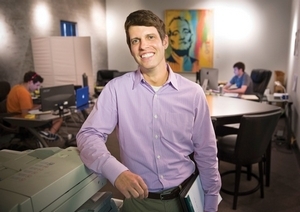In an article published by the Baton Rouge Business Report, Brian discusses how he keeps his team from feeling burnt out and disengaged. To read the original article, click here.
The breaking point – Employee burnout and disengagement are on the rise.
— By April Castro, Published Sep 16, 2013 at 6:00 pm (Updated Sep 16, 2013)
So he gets out of the office.
“A change of scenery can work wonders on me,” says Rodriguez, founder and president of Gatorworks, a Web and graphic design firm. “If I can find a coffee shop where I can just sit down with my laptop, then I’m raring to go.”

Burnout, which often accompanies workplace disengagement, is something that affects most Americans at some point in their lives. A recent Gallup poll found that a staggering 20 million U.S. workers are “actively disengaged” in their work, a trend that costs the economy billions in lost productivity.
Author and employee engagement expert Trevor Wilson says problems usually appear in three stages: disengagement, then burnout, potentially followed by the most severe form: active disengagement.
“Burnout is definitely a problem that affects a lot of people, especially in the creative service industry,” Rodriguez says. “Sometimes it can be paralyzing and leave you very unproductive. If it’s not addressed, or if you don’t learn to identify when you’re getting burned out and have the ability to do something about it, then it can lead to poor work performance and maybe even carry into your personal life.”
But experts say that employers can take action to lessen and even reverse the negativity and unhappiness that come with employee disengagement and burnout.
“This is where company culture comes into play,” Rodriguez says. “What I mean by ‘culture’ is our working environment. Is it stressful? Is it tense? Or is ‘N Sync playing in the background?
“I need my team to want to come to work and enjoy each other’s company because they’ll be spending a lot of time together. So if going out for a long lunch, taking a group coffee break, or listening to some old ’90s music for kicks is what helps them meet the deadline, then by all means, have at it.”
At Woman’s Hospital, Donna Bodin, vice president of Human Resources, places a premium on keeping employees engaged.
“We’ve found that sometimes it’s the simple things that empower employees, such as allowing staff, in specific positions, to create their own work schedules through a self-scheduling model,” Bodin says. “They’ve told us that this helps them feel like they have more control over some of the decisions that affect them.”
Keeping employees informed, Bodin says, is one of the easiest ways to reduce their stress.
“Woman’s distributes a brief, weekly employee email … that provides staff with a quick snapshot of what’s happening that week at the hospital,” she says. “An online ‘Ask Anything’ forum allows employees to ask questions and helps resolve rumors.”
A Woman’s Employee Wellness Program encourages a healthy diet and exercise for overall well-being through free exercise classes and healthy-cooking demonstrations.
Wilson, author of The Human Equity Advantage, offers simple guidance for managing disengagement among employees.
“One of the secrets is to play to individuals’ strengths and manage around weakness,” he says.
Wilson has developed a formula that he says is fail-proof in helping managers eliminate disengagement and burnout among their staff without terminating employees.
“There is a solution,” Wilson says. “I call it human equity—the unique assets each individual brings to the workplace that are often unrecognized. Recognizing and leveraging your own human equity, as well as that of your employees, addresses not only the incredible waste of human capital illustrated in the recent [Gallup] poll but also related concerns business leaders share, including the constant need for innovation.”
His method, which he named the SHAPE V Talent Model, is designed to uncover valuable intangibles in employees so that managers can redirect efforts to maximize employee engagement and satisfaction. His model consists of determining an individual’s strengths, heart, attitude, personality, experience and virtues. He uses free online tools like the VIA Survey to identify character traits and strengths as well as the Kolbe A Index. The latter is touted by its creators to reveal, more than personality, what people will and won’t do.
“Instead of getting rid of the disengaged, start getting rid of the disengagement that’s really caused by people doing things that they should never be doing,” he suggests.
Wilson recommends managers first use his talent model on themselves, then apply it to high-potential employees within the organization.
“The great managers out there have always understood this,” Wilson says. “In a very mechanical way, [we’re] doing what some of the great managers have done over the last thousand years. These tools are readily available.”
For Rodriguez, the best approach is often to stop burnout before it gets out of hand.
“I’ve come to realize that burnout is much more likely to happen in a stressed, and unhappy environment,” he says. “Basically, when [employees] get to a point where I can see they’re burned out, I don’t mind if they take a step back from the computer.
“In the end, it may be worse if they don’t,” he adds. “Their work will suffer and their attitude will turn sour. Employee burnout affects more than just the employee, it affects the entire company.”